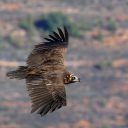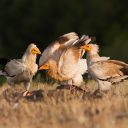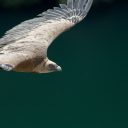The majestic and instantly recognisable sight of a vulture soaring overhead on thermals of air or feeding at a carcass is truly captivating. Two hundred years ago Bearded, Cinereous, Egyptian and Griffon Vultures were among the most common breeding bird species in the mountains of central and southern Europe. Yet the decreasing availability of food, coupled with habitat loss, persecution and poisoning, saw vultures disappear from most of their European range, with populations significantly smaller and increasingly isolated by the 1960s.
Today, as a result of conservation efforts, European vulture populations are steadily recovering. In many regions of their former range, vultures soaring the sky has become a common and spectacular sight again.
WHY PROTECT VULTURES?
Vultures feed on carrion, the remains of dead animals, and act as the ‘rubbish collectors’ of the natural world offering a valuable socioeconomic service to local communities. Feeding on animal remains, vultures likely help eliminating potentially harmful bacteria from the environment, potentially limiting the spread of diseases such as anthrax and rabies.
Vulture conservation work not only protects these ecologically important birds but as umbrella species, these efforts also benefit their habitat and other wildlife such as other endangered raptors like Imperial and Golden Eagles as well as large herbivores such as deer, ibex and European Bison.
VULTURES UNDER THREAT
Persecution, poisoning, habitat loss and changes in farming practices leading to decreasing food availability saw Europe’s four species of vultures being driven close to extinction across much of the continent over the 19th and 20th Centuries. Today, due to dedicated conservation actions, the Bearded, Cinereous and Griffon Vulture populations are recovering.
However, Europe’s vulture species still face those historical challenges in some European countries and a range of emerging threats from; poisoning after eating the remains of game animals laced with traces of lead ammunition or livestock treated with veterinary products, and collisions with electricity infrastructure including wind farms and power-lines.
WORKING TOGETHER TO SAVE VULTURES
The once common sight of a Bearded Vulture soaring above the Alps mountain range was consigned to the past in 1913 when the last individual was shot at Aosta Valley. However, a unique partnership spanning five countries involving zoos, government agencies and non-governmental organisations led by passionate conservationists began to reintroduce the species to the mountain chain. The captive-breeding programme commenced in 1978, with the first releases taking place in 1986 in Austria. After breeding and releasing hundreds of birds, today the species is firmly re-established across the Alpine arc with 300 individuals, making the reintroduction project one of the world’s most successful wildlife comeback stories. — vulture conservation can work!
Using our experience in this groundbreaking conservation initiative we have since been collaborating across Europe with governments, businesses, local communities and other non-governmental organizations to protect and conserve the Bearded Vultures as well as the other European vulture species — Cinereous, Egyptian and Griffon Vultures.
ACTION PLANS FOR VULTURE CONSERVATION
Species Action Plans are created by conservation partners, scientists, charities, governments and local groups and are tools for identifying and prioritising measures to restore the populations of vultures across their range. They provide information about the status, ecology, threats and current conservation measures for each species of vulture and list key actions that are required to improve their conservation status.
VULTURE MULTI-SPECIES ACTION PLAN
Officially adopted by the United Nation’s Convention on the Conservation of Migratory Species of Wild Animals (CMS), the Vulture Multi-Species Action Plan is the first comprehensive, strategic conservation plan covering the 128 nations where all 15 species of migratory African-Eurasian vultures are found. This plan promotes concerted, collaborative and coordinated international actions to rapidly halt current population declines.



